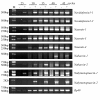Antimicrobial peptide-like genes in Nasonia vitripennis: a genomic perspective
- PMID: 20302637
- PMCID: PMC2853521
- DOI: 10.1186/1471-2164-11-187
Antimicrobial peptide-like genes in Nasonia vitripennis: a genomic perspective
Abstract
Background: Antimicrobial peptides (AMPs) are an essential component of innate immunity which can rapidly respond to diverse microbial pathogens. Insects, as a rich source of AMPs, attract great attention of scientists in both understanding of the basic biology of the immune system and searching molecular templates for anti-infective drug design. Despite a large number of AMPs have been identified from different insect species, little information in terms of these peptides is available from parasitic insects.
Results: By using integrated computational approaches to systemically mining the Hymenopteran parasitic wasp Nasonia vitripennis genome, we establish the first AMP repertoire whose members exhibit extensive sequence and structural diversity and can be distinguished into multiple molecular types, including insect and fungal defensin-like peptides (DLPs) with the cysteine-stabilized alpha-helical and beta-sheet (CSalphabeta) fold; Pro- or Gly-rich abaecins and hymenoptaecins; horseshoe crab tachystatin-type AMPs with the inhibitor cystine knot (ICK) fold; and a linear alpha-helical peptide. Inducible expression pattern of seven N. vitripennis AMP genes were verified, and two representative peptides were synthesized and functionally identified to be antibacterial. In comparison with Apis mellifera (Hymenoptera) and several non-Hymenopteran model insects, N. vitripennis has evolved a complex antimicrobial immune system with more genes and larger protein precursors. Three classical strategies that are likely responsible for the complexity increase have been recognized: 1) Gene duplication; 2) Exon duplication; and 3) Exon-shuffling.
Conclusion: The present study established the N. vitripennis peptidome associated with antimicrobial immunity by using a combined computational and experimental strategy. As the first AMP repertoire of a parasitic wasp, our results offer a basic platform for further studying the immunological and evolutionary significances of these newly discovered AMP-like genes in this class of insects.
Figures












Similar articles
-
Comparative genomics analysis of five families of antimicrobial peptide-like genes in seven ant species.Dev Comp Immunol. 2012 Oct;38(2):262-74. doi: 10.1016/j.dci.2012.05.003. Epub 2012 May 19. Dev Comp Immunol. 2012. PMID: 22617650
-
Characterization of a chimeric antimicrobial peptide uncovers evolutionary significance of exon-shuffling.Biochem Biophys Res Commun. 2012 Nov 23;428(3):360-4. doi: 10.1016/j.bbrc.2012.10.059. Epub 2012 Oct 23. Biochem Biophys Res Commun. 2012. PMID: 23103428
-
OGS2: genome re-annotation of the jewel wasp Nasonia vitripennis.BMC Genomics. 2016 Aug 25;17(1):678. doi: 10.1186/s12864-016-2886-9. BMC Genomics. 2016. PMID: 27561358 Free PMC article.
-
Insect antimicrobial peptides: structures, properties and gene regulation.Protein Pept Lett. 2005 Jan;12(1):3-11. doi: 10.2174/0929866053406011. Protein Pept Lett. 2005. PMID: 15638797 Review.
-
Anti-microbial peptides: from invertebrates to vertebrates.Immunol Rev. 2004 Apr;198:169-84. doi: 10.1111/j.0105-2896.2004.0124.x. Immunol Rev. 2004. PMID: 15199962 Review.
Cited by
-
Molecular characterization of antimicrobial peptide genes of the carpenter ant Camponotus floridanus.PLoS One. 2012;7(8):e43036. doi: 10.1371/journal.pone.0043036. Epub 2012 Aug 9. PLoS One. 2012. PMID: 22912782 Free PMC article.
-
Disentangling a Holobiont - Recent Advances and Perspectives in Nasonia Wasps.Front Microbiol. 2016 Sep 23;7:1478. doi: 10.3389/fmicb.2016.01478. eCollection 2016. Front Microbiol. 2016. PMID: 27721807 Free PMC article. Review.
-
Insect Innate Immunity Database (IIID): an annotation tool for identifying immune genes in insect genomes.PLoS One. 2012;7(9):e45125. doi: 10.1371/journal.pone.0045125. Epub 2012 Sep 12. PLoS One. 2012. PMID: 22984621 Free PMC article.
-
Characterizing the infection-induced transcriptome of Nasonia vitripennis reveals a preponderance of taxonomically-restricted immune genes.PLoS One. 2013 Dec 27;8(12):e83984. doi: 10.1371/journal.pone.0083984. eCollection 2013. PLoS One. 2013. PMID: 24386321 Free PMC article.
-
Massively parallel amplicon sequencing reveals isotype-specific variability of antimicrobial peptide transcripts in Mytilus galloprovincialis.PLoS One. 2011;6(11):e26680. doi: 10.1371/journal.pone.0026680. Epub 2011 Nov 7. PLoS One. 2011. PMID: 22087233 Free PMC article.
References
-
- Ezekowitz RA, Hoffmann JA. Innate immunity. Totowa, New Jersey: Human press; 2003.
Publication types
MeSH terms
Substances
LinkOut - more resources
Full Text Sources
Research Materials

